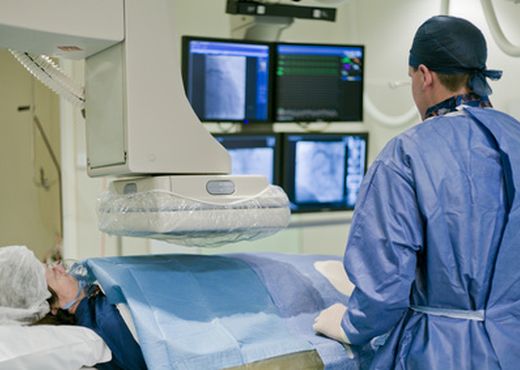Courtesy of Dr. Carlos Fava.

This study analyzed 127 consecutive patients in the USpella registry from 2008 to 2015. These subjects underwent high-risk angioplasty with unprotected LMCA lesion with defective ventricular functioning. Patients with cardiogenic shock were excluded from the analysis. The chosen device was Impella (Abiomed, Danvers, MA).
Patient age was 70 years old, and most subjects were male. Patients with chronic obstructive pulmonary disease (COPD): 22%; diabetes: 48%; prior acute myocardial infarction: 42%; renal dysfunction: 25.5%; prior angioplasty: 51.6%. Half of all patients presented congestive heart failure and 74% of them were in functional class III or IV at the time the procedure was carried out. Acute coronary syndrome was present in 19% of patients. Ejection fraction was 28%, capillary pressure was 20.5 mm hg, and their heart rate was 2.3 L/min/m2.
The Society of Thoracic Surgeons (STS) Predicted Risks of Mortality and Morbidity rates were 3.6% and 22.6%, respectively. The SYNTAX score was <22 in 18.8% of all cases; >23 and <32 in 37% of cases, and >33 in the remaining 44% of all cases.
The number of affected vessels was 2.1/patient. About 87% of patients presented distal LMCA lesion, and they received a provitional stent in 82% of cases. About 2.07 ± 0.97 stent/patient were implanted; 10% of patients underwent triple vessel angioplasty, and the residual SYNTAX score was 7.86. Impella device implantation was successful in all patients and hemodynamic support duration was 1.65 ± 4.69 h.
The rates for in-hospital and 30-day mortality were 1.43% (2 patients) and 2.1% (3 patients), respectively. The 30-day major adverse cardiovascular events (MACE) rate was 2.36%. There were no deaths related to Impella. Only 3.9% of patients required a transfusion and 1 patient presented a major vascular complication that required surgery. Furthermore, only 1 patient experienced acute renal failure.
Conclusion
This large retrospective evaluation of the USpella registry supported the feasibility, safety, and hemodynamic usefulness of the Impella device for unprotected LMCA angioplasty, with acceptable in-hospital and 30-day MACE rates.
Editorial Comment
This study showed that Impella device use was feasible and safe, with good 30-day outcomes for high-risk angioplasty and revascularization with a residual SYNTAX score <8.
This was possible in patients with a low or intermediate score, but not in patients with a high score, since this is a limitation for angioplasty as regards diffuse coronary disease or chronic occlusion.
The fact that very few patients presented major vascular complications and required transfusions is also positive. However, we should still acknowledge that, currently, this technology is expensive and unavailable in most sites worldwide.
Courtesy of Dr. Carlos Fava.
Original title: Real-World Supported Unprotected Left Main Percutaneous Coronary Intervention with Impella Device.
Reference: Data from the USpella Registry. Theodore Schreiber. Catheterization and Cardiovascular Intervention 2017 Early View
Subscribe to our weekly newsletter
Get the latest scientific articles on interventional cardiology
We are interested in your opinion. Please, leave your comments, thoughts, questions, etc., below. They will be most welcome.




